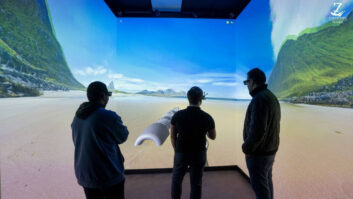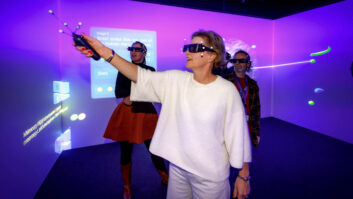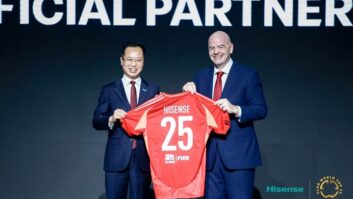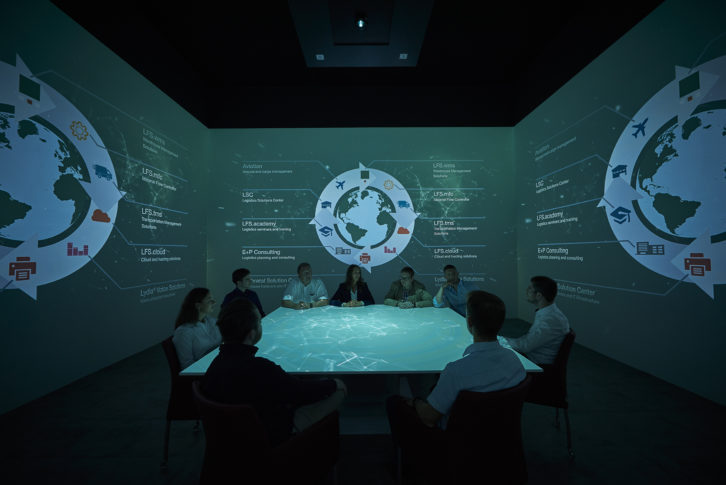
Ehrhardt + Partner Group (EPG) has opened the world’s first VR CAVE meeting room, or ‘holodeck’, thanks to the expertise of integrator Viscon and VIOSO’s calibration technology.
EPG’s 7m x 7m holodeck, which seats up to 12 people, uses multiple projectors to relay a wide variety of visual content onto four walls and the table top. This means that the room can now be used for anything from 360° simulations to immersive corporate presentations to realistic visualisations of the company’s logistical processes – all without the use of any VR headsets or glasses.
“EPG has used VR to our advantage for some time, primarily with VR glasses to help us in the field of logistics planning and consulting,” said Dennis Kunz, EPG’s director of marketing.
“Our target for the new building was to build up VR warehouse and logistics projects that could be used without wearing glasses. We conducted a great deal of research online regarding VR CAVE solutions and Viscon immediately grabbed our attention with its track record of special and unique projects.”
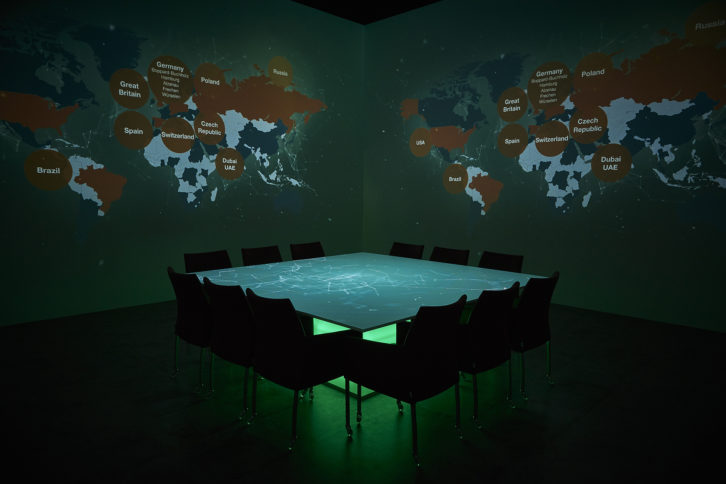
“It all began for us back in March 2017,” explained Inga Mölders, sales manager for Viscon. “EPG came to us with the idea to build a ‘holodeck’ that could serve as a showroom, a meeting space and a 3D engineering/construction virtual CAVE. To equip a single space so that it could perform all of these tasks was not going to be easy but, after many internal discussions, we were able to pitch our idea in the autumn of that year.”
The main objective for the holodeck was to create a level of immersion that would allow users to have discussions with direct reference to realistic representations of actual situations. This, in turn, would help them to plan new and more effective solutions for their customers.
Mölders continued: “The main challenge was that we were one of the smallest components in a brand-new building. Our systems require a lot of structural planning, especially in terms of lighting, climate and the nature of the projection surface. Luckily, we had the chance to have personal discussions with all project leaders from the different trades associated with the building’s construction long before they began.”
Viscon decided to involve VIOSO as its main partner on the project, primarily on the strength of its visualisation software solutions.
CEO and founder of VIOSO, Benjamin Fritsch, said: “VIOSO Anyblend was chosen to create the overall unique projection space with blending, warping and eye-point correction, which was particularly needed for its flexibility. Elsewhere, Wings VIOSO acted a media server across multiple sites to distribute content, control layouts, and convert videos in real time. We also decided to control the lighting and projectors using AVIO.”
The entire system was to be contained within an individual ‘media cube’, which was especially designed with the holodeck in mind.
For Fritsch, one of the main factors was to identify the correct technology to use without limiting usage for the client. “In this case, we needed the power of multiple PCs to run the ‘construction space’ within the holodeck, as well as needing the simple flexibility of just being able to show a video across the room or feeding multiple different sources. We installed powerful multi-client media servers in combination with a complex capture and control architecture. Multiple tools were used to create this immersive experience.
“Technology-wise, the challenge was to create a sense of immersion in a cube-shaped room without the use of any special head-tracing systems. We found some clever ways to wrap around the projection in the corners and implemented filters to convert 360° videos to the different sites.”
“Using software from VIOSO throughout this project gave both Viscon and the customer a great deal of security, especially in future software support,” added Mölders. “The software is a lot easier to use than it first appears, to the point where the customer can understand the functionality and workspace very quickly. For this reason, the hardware in our projects becomes less important, because the software should be able to handle whatever is thrown at it.”
Viscon decided to use four Barco F50 WQXGA (2,560 x 1,600 px) units to cover the holodeck – one for each wall – and a single Panasonic Laser WUXGA (1,920 x 1,200 px) to cover the table surface. This impressive visual arsenal was complemented by a 5.1 surround Genelec audio system.
“Being an independent system integrator is great for us, as it gives us the freedom to choose the most suitable partners for each individual project,” said Mölders. “We are very happy to have VIOSO as our server and software partner on the EPG holodeck. Using the whole software package from VIOSO has given the customer (and us) security, especially in future software support.”
Fritsch agreed: “I think the holodeck project was one that provided a great deal of challenges as it evolved, but the finished product is a sight to behold. We are very grateful to work with both Viscon and EPG, and we will continue to work alongside them to ensure our technology is being used to its fullest potential. Seeing the holodeck’s continuous usage today makes us very proud.”
